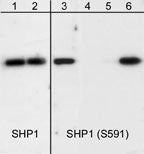Anti-SHP1 (C-terminal region) Antibody
- 产品详情
- 实验流程
- 背景知识
Application
| WB, ICC, IP |
|---|---|
| Primary Accession | P29350 |
| Host | Mouse |
| Clonality | Mouse Monoclonal |
| Isotype | IgG1 |
| Clone Names | M160 |
| Calculated MW | 67561 Da |
| Gene ID | 5777 |
|---|---|
| Other Names | PTP1C, SHPTP1 |
| Dilution | WB~~1:1000 ICC~~N/A IP~~N/A |
| Storage | Maintain refrigerated at 2-8°C for up to 6 months. For long term storage store at -20°C in small aliquots to prevent freeze-thaw cycles. |
| Precautions | Anti-SHP1 (C-terminal region) Antibody is for research use only and not for use in diagnostic or therapeutic procedures. |
| Shipping | Blue Ice |
For Research Use Only. Not For Use In Diagnostic Procedures.
Provided below are standard protocols that you may find useful for product applications.
BACKGROUND
SHP1 (PTP1C, SH-PTP1, or HCP) is a protein-tyrosine phosphatase (PTP) involved in cell migration, cell proliferation, and immune cell function. This phosphatase contains two N-terminal SH2 domains and a C-terminal phosphatase domain. SHP1 associates with a variety of cytokine and growth factor receptors and regulates signal transduction through dephosphorylation of these receptors or their downstream effectors. Downstream of receptor activation, SHP1 regulates the transcriptional activity stimulated by JAK/Stat and MAPK pathways. SHP1 activity is regulated by both tyrosine and serine phosphorylation. Phosphorylation of Tyr-536 and Tyr-564 stimulates phosphatase activity and promotes interaction with Grb-2. Serine phosphorylation at Ser-591 is mediated by PKCα and leads to inhibition of phosphatase activity. Thus, phosphorylation at tyrosine relative to serine residues may be regulated by different cell signaling pathways to control SHP1 activity.
终于等到您。ABCEPTA(百远生物)抗体产品。
点击下方“我要评价 ”按钮提交您的反馈信息,您的反馈和评价是我们最宝贵的财富之一,
我们将在1-3个工作日内处理您的反馈信息。
如有疑问,联系:0512-88856768 tech-china@abcepta.com.























 癌症的基本特征包括细胞增殖、血管生成、迁移、凋亡逃避机制和细胞永生等。找到癌症发生过程中这些通路的关键标记物和对应的抗体用于检测至关重要。
癌症的基本特征包括细胞增殖、血管生成、迁移、凋亡逃避机制和细胞永生等。找到癌症发生过程中这些通路的关键标记物和对应的抗体用于检测至关重要。 为您推荐一个泛素化位点预测神器——泛素化分析工具,可以为您的蛋白的泛素化位点作出预测和评分。
为您推荐一个泛素化位点预测神器——泛素化分析工具,可以为您的蛋白的泛素化位点作出预测和评分。 细胞自噬受体图形绘图工具为你的蛋白的细胞受体结合位点作出预测和评分,识别结合到自噬通路中的蛋白是非常重要的,便于让我们理解自噬在正常生理、病理过程中的作用,如发育、细胞分化、神经退化性疾病、压力条件下、感染和癌症。
细胞自噬受体图形绘图工具为你的蛋白的细胞受体结合位点作出预测和评分,识别结合到自噬通路中的蛋白是非常重要的,便于让我们理解自噬在正常生理、病理过程中的作用,如发育、细胞分化、神经退化性疾病、压力条件下、感染和癌症。






